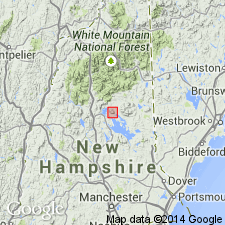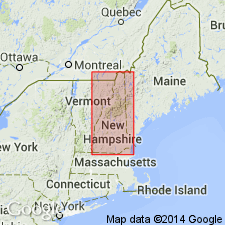
- Usage in publication:
-
- Winnipesaukee quartz diorite*
- Modifications:
-
- Revised
- Reinstated
- Redescribed
- Age modified
- Dominant lithology:
-
- Quartz diorite
- AAPG geologic province:
-
- New England province
Summary:
Thin section examination of rock called Winnipesaukee gneiss by some workers shows it to be a quartz diorite. Name changed to Winnipesaukee quartz diorite in accordance with work of M.P. Billings and A.P. Smith in Mt. Chocorua quad. It is a subdivision of Chatham granite of some workers (Billings, 1928). Described as light- to medium-gray, medium-grained, faintly foliated, locally streaky quartz diorite. Cut in places by small pegmatite veins and aplite dikes. Assigned to New Hampshire magma series of probable Late Devonian age. [GNC records show that this was actually a reinstatement of a term first used by Hitchcock in 1874, but falling out of disuse and formally abandoned by Billings in 1935.]
Source: GNU records (USGS DDS-6; Reston GNULEX).

- Usage in publication:
-
- Winnipesaukee Tonalite*
- Modifications:
-
- Overview
- AAPG geologic province:
-
- New England province
Summary:
Used as Winnipesaukee Tonalite of New Hampshire Plutonic Suite. Previously called Winnipesaukee Quartz Diorite of Billings (1955). Lithologic term changed from Quartz Diorite to Tonalite in accordance with rock classification scheme of Streckeisen (1973). Consists of gray, massive to foliated tonalite, with minor quartz diorite, granodiorite, and granite. Probably coeval with Spaulding Tonalite. Age changed from Late Devonian(?) to Early Devonian based on isotope age of 400 +/-2 Ma using U/Pb methods (J.N. Aleinikoff, oral commun., 1990). Report includes geologic map and correlation chart, and 1:500,000-scale map showing plutons and sample localities for age dating.
Source: GNU records (USGS DDS-6; Reston GNULEX).
For more information, please contact Nancy Stamm, Geologic Names Committee Secretary.
Asterisk (*) indicates published by U.S. Geological Survey authors.
"No current usage" (†) implies that a name has been abandoned or has fallen into disuse. Former usage and, if known, replacement name given in parentheses ( ).
Slash (/) indicates name conflicts with nomenclatural guidelines (CSN, 1933; ACSN, 1961, 1970; NACSN, 1983, 2005, 2021). May be explained within brackets ([ ]).

